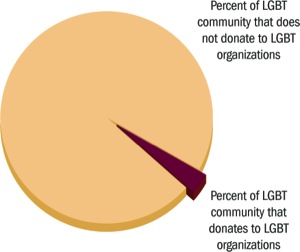
The newly-released Momentum Report by the Movement Advancement Project (MAP) shows the majority of LGBT Americans still face inequities, hardships and laws that are hostile to their well-being, despite the latest high-profile advances in equality.
“There has been a tremendous amount of important progress over the last few years,” said Ineke Mushovic, executive director of MAP.
For example, marriage for gay couples in New York, certification of Don’t Ask, Don’t Tell repeal and the passage of transgender-inclusive non-discrimination protections in Connecticut have fueled optimism about the pace of change for the LGBT community.
“But the kind of momentum we’re seeing can be a double-edged sword,” Mushovic continued. “While it has provided vital protections for gay and transgender people and their families, it can also bring with it a risk of complacency.”
MAP’s biennial Momentum Report measures progress toward the LGBT movement’s goal of equal opportunities. The report measures four broad areas of progress: Changes in the social and political climate, progress on key policy issues, improvements in the lived experiences of LGBT Americans and the strength and capacity of LGBT movement organizations.
The positives
The new report finds significant advances in equality for LGBT people since the beginning of 2009 across a number of key areas, including:
• Increasing public support. For example, since August 2010, six national polls have found majority support for allowing gay and lesbian couples to marry.
• Expansion of marriage or relationship recognition for gay couples. Four states (Iowa, New Hampshire, New York and Vermont) and D.C. have extended marriage, and six (Delaware, Hawaii, Illinois, Nevada, Rhode Island and Washington State) have extended comprehensive relationship recognition through civil unions or domestic partnerships.
• Repeal of Don’t Ask, Don’t Tell. Beginning in September, gay, lesbian and bi military personnel are expected to be able to openly serve their country.
• Adoption bans struck down. Courts in Arkansas and Florida have struck down statewide bans on adoption by gay parents.
• New non-discrimination and anti-bullying protections. Four more states included gay and/or transgender people in their non-discrimination laws, while six more states passed safe schools or anti-bullying laws.
The negatives
The Momentum Report also highlights some of the most significant inequities LGBT people continue to face amid this progress:
• LGBT couples still have no legal protections in 30 states.
• LGB employees can be unfairly fired in 29 states. Transgender employees can be unfairly fired in 35 states.
• 32 states lack safe schools laws that prohibit bullying and harassment based on sexual orientation, and 35 states lack similar laws based on gender identity.
• Seven states effectively ban second-parent adoption (up from four states in 2001), with North Carolina recently rolling back second-parent adoption by a court ruling.
• The federal government’s refusal to recognize same-sex couples means that even couples who legally marry in their state are denied fundamental protections.
“The advances since 2009 give us good reason to be optimistic,” Mushovic said. “But we must be careful to not allow this accelerating progress to obscure the experiences of millions of gay and transgender Americans who still live in daily fear.”
The complete report, along with interactive state maps, is available online at lgbtmap.org.
Community support
Despite the laws of the land, public support is increasing steadily. This year, 56 percent of Americans said they “believe gay or lesbian relations are morally acceptable,” an increase of 16 percent in the past 10 years.
In August 2010, for the first time, a major national poll (by CNN) found that a majority of Americans (52 percent) agreed that “gays and lesbians should have a constitutional right to get married and have their marriage recognized by law as valid.” Since then, five additional national polls have shown a majority of Americans in support of marriage.
Bipartisan politics
There is evidence that support for LGBT issues is increasingly becoming bipartisan, according to the report.
For example, a growing number of elected officials and prominent political figures across party lines have expressed support for marriage for gay couples.
Show me the money
The MAP report emphasizes the key to progress is the strength, influence and health of LGBT national and local organizations. There are 553 LGBT organizations across the U.S., MAP’s analysis shows, with combined revenues of $563 million.
“While this revenue is impressive, it pales in comparison to the resources of anti-LGBT organizations,” the report reads. “The 10 largest anti-LGBT organizations have combined revenues of $337 million, almost four times the total revenues of the 10 largest LGBT advocacy organizations ($94.3 million).”
Where are the LGBT organizations getting their money? Not from the community. MAP’s analysis found that fewer than 3.4 percent of LGBT adults have donated to one of these advocacy groups.













